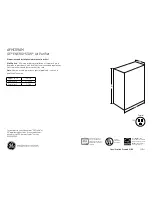
2
AbOUT THE HEAT PUMP
Your heat pump is a unique, all weather comfort-control
appliance that will heat and cool your building year round
and provide energy saving comfort. It’s an unknown fact
that heat is always in the air, even when the outside
temperature is below freezing. The heat pump uses this
basic law of physics to provide energy saving heat during
the winter months. For example, If the outdoor temperature
is 47° F (8° C), your heat pump can deliver approximately
3.5 units of heat energy per each unit of electrical energy
used, as compared to a maximum of only 1 unit of heat
energy produced with conventional heating systems.
In colder temperatures, the heat pump performs like
an air conditioner run in reverse. Available heat energy
outside the building is absorbed by the refrigerant and
exhausted inside. This efficient process means you only
pay for “moving” the heat from the outdoors to the indoor
area. You do not pay to generate the heat, as is the case
with more traditional furnace designs.
During summer, the heat pump reverses the flow of the
heat-absorbing refrigerant to become an energy-efficient,
central air conditioner. Excess heat energy inside the home
is absorbed by the refrigerant and exhausted outside the
building.
ImPORTANT SAFETY INFORmATION
WARNING:
To avoid possible equipment damage, fire, or
personal injury, the following instructions must
be observed regarding unit maintenance and
operational procedures.
The Q6SP Series package heat pump rooftop unit has
been designed and built to provide many years of safe
and dependable comfort, providing it is properly installed
and maintained. With regular maintenance, this unit will
operate satisfactorily year after year. Abuse, improper
use, and/or poor maintenance can shorten the life of the
appliance and create unsafe hazards. A regular service
and maintenance schedule should be established to
ensure efficient and safe operation of the unit. See System
Maintenance on page 3.
• To achieve optimum performance and minimize
equipment failure, it is recommended that periodic
maintenance be performed on this unit. The ability
to properly perform maintenance on this equipment
requires certain mechanical skills and tools.
• The area around the unit and the vicinity of any other
appliances must be kept clear and free of combustible
materials, gasoline, and other flammable vapors and
liquids. Do not store or use flammable items such as
paint, varnish, or strippers in the vicinity of the unit.
• Do not use the area around the unit as a storage area.
This area must be kept clean and clear of loose or
exposed insulation materials. Examine the unit’s area
when it is installed or when insulation is added, since
some insulation materials may be combustible.
• Do not use this appliance if any part has been under
water. Immediately call a qualified service technician
to inspect the unit and to replace any part of the
electrical control system that has been under water.
• Familiarize yourself with the controls that shut off the
electrical power to the unit. If the unit is to be shut down
for an extended period of time, turn off the electrical
power. For your safety always turn off the electrical
power before performing service or maintenance on
the furnace.
• Do not block or obstruct air openings on the unit or air
openings supplying the area where it is installed.
• The duct connections must be physically sound
and sealed to the unit’s casing. The return air and
circulating air ductwork must not be connected to any
other heat producing device such as a fireplace insert,
stove, etc. Improperly installed ductwork may result
in fire, explosion, personal injury, carbon monoxide
poisoning, or property damage.
OPERATING INSTRUCTIONS
Thermostat styles vary. Some models may not include
the AUTO mode and others will have the AUTO in place
of the HEAT and COOL. Others may include all three.
Some thermostats may have anti-short cycle protection
built in causing a delay in one or both stages. A protective
timer circuit may hold the compressor(s) off for up to 5
minutes following a previous operation or an interruption
of the main power. Please refer to the thermostat’s User
Manual for detailed programming instructions.
The thermostat should be mounted about 5 feet above the
floor on an inside wall and not on an outside wall or other
location where its operation may be adversely affected by
radiant heat from fireplaces, sunlight, or lighting fixtures,
and convective heat from warm air registers or electrical
appliances.
Cooling Operation
1. Set the thermostat system mode to COOL and the
thermostat fan mode to AUTO (See Figure 1, page 3).
2. Set the thermostat temperature selector to the desired
temperature level. The outdoor fans, compressors,
and indoor blower will all cycle on and off to maintain
the indoor temperature at the desired cooling level.
NOTE:
This unit is equipped with a five minute anti-
short cycle timer (ASCT) built in to the defrost control
board for Stage 1 Heat or Cool. If the thermostat tem-
perature level is re-adjusted, or if the system mode is
changed, the compressor may not start immediately.
Stage 2 Heat/Cool has no ASCT protection and can
operate immediately upon a call from the thermostat.






















